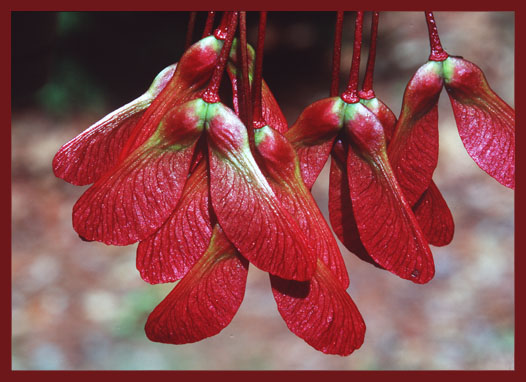
Young Maple Seeds. Photo by David Fingerhut.
Are maple seeds edible? Yes. Are they prime foraging food? Opinions vary. The delicate samaras above happen to be red but they can also be green. Late the auto-rotating wings will turn brown. Locally the trees are so heavy with seeds they appear red from a distance. As for eating them what you need to do is taste them first. If they are not bitter you can tear off the wings and eat them raw though some folks eat the soft wings, too. If they are bitter they need to be cooked in boiling water, cooled, then tasted. They should be less bitter. You may have to boil them again. Non-bitter seeds can also be roasted or sun-dried. Some American Indians sprouted the seeds for a treat. I do not know of any toxic maple seeds to humans but red maple (Acer rubrum) leaves and seeds are toxic to horses. Though I do recall we had a red maple intentionally planted in the barnyard. My father liked the looks of them. Our horses — definitely leaves eaters — left it alone. To read more about maples go here.
While contemplating the making of a video on local mallows I decided to take pictures of some Turk’s Caps (Malvaviscus penduliflorus) There are a few in my neighborhood blossoming heavily. But first I thought I would look at a teaching garden a parochial school has across the street. I have a standing invitation to visit as I like. Uncharacteristically, the gate was closed so after jiggling the paddle lock I sauntered down the street looking at this or that roadside plant taking a picture here and there. Along the way I avoided a small man with a large German shepherd. Often not a good combination. Soon I found the Turk’s Caps and while framing a photo I heard a voice behind me asked “can I help you?” It was Napoleon and fraulein Josephine again. After contemplating a moment I gave my usual reply to that question: “No.” I will shorten the story considerably but apparently I look like a shady character who was casing out the street to burglarize church and home and my one-word reply and leave-me-alone attitude was further proof of my miscreant intent. He was a resident of the street who had somehow managed to never notice me during the past 14 years, which is actually irrelevant. Legally, if you can see it from a public road you can take a picture of it. You also have the right to be on a public road anywhere, whether you live in the neighborhood or not. The presumptuous misunderstanding was ironed out about the same time the two police cars arrived on the scene. That is something of a personal best. Usually I only rate one police car.
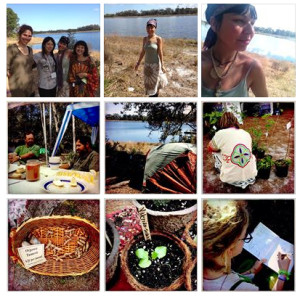
Florida Herbal Conference photo montage by Kiki Lin.
The Florida Herbal Conference 2014 is now history but only as a date. The experiences and learning will reverberate forward for many years. It also made me realize I need to spend more time at this particular conference and to attend more such events in the future. I would like to thank Emily Ruff for inviting me for the third year in a row. I had the opportunity to teach two classes (and learned the wisdom of having a portable sound system for huge classes.) I got to attend some presentations — nice job Andy (Firk) — and talk mushrooms with Mycol Stevens and Joshua Buchanan. Now is also the time to put a note in your calendar to attend the 2015 conference. This year’s was sold out which tells you want a premium event it has become. Be there next year.
Occasionally poisonous plants are mentioned here and this edition is one of those times. Locally the Cherry Laurel (Prunus caroliniana) is blossoming and quite attractive. It produces hard, green, pointed fruit that slowly turns blue then black. It is a toxic tree. The fruit and leaves contain prulaurasin which hydrolyzes to racemic mandelonitrile and glucose and releases hydrogen cyanide, also know as Prussic Acid. Consumed it can easily kill you, and any livestock that grazes on it. I know of a 600-pound steer that ate some leaves and was dead in 20 minutes. When the leaves are crushed they have the aroma of almonds or maraschino cherries. A significant percentage of the population can’t detect those aromas. Anyone who can’t, however, can look at the underside of the leaves for an identifying characteristic (among many others of the tree.) The leaves will have two glands. They are red when the leaf is young, turning gray as the leaf ages, and often in old age they will totally fade away. Thus one surveys several young leaves. Also young leaves are toothed and older leaves tend to not have teeth.
What Do You See #5. Can you find four different edible species in the photo directly below? The answer will be published here next week or you can read it on the What Do You See? board in the Green Deane Forum. Further below is the answer to last week’s What Do You See? #4
What Do You See 04? (photo below) is a bit of a hodgepodge and a mystery. There are three Oxalis in the picture, and like all Oxalis, all edible. One is native to Florida and the other two come (perhaps) from the Caribbean islands. 1A looks like Oxalis intermedia. It has delta or “butterfly” shaped leaves. Is very tart and has pink blossoms. You can seen the blossom under the upper 1A. 1B also has a pink blossom and looks like O. corymbosa but with several hundred of them the exact identification can be iffy. Also in the picture is the native. 1C, O. stricta which has yellow blossoms (one of which not quite open can be seen above the upper 1A) All of these are tart with oxalic acid. The median lethal does is to eat 12 pounds of these at once. They are quite safe in lesser amount unless you have a family history of calcium kidney stones. THEY ARE NOT CLOVERS. The internet is just plain wrong about that. A clover leaflet is shaped like a T with each little leaf having a short stem. These leaves are equally distributed around a center stem and the leaves themselves do not have stems. They are Oxalises not clovers.#2 is a spiny sow thistle with our two examples at different ages. #3 is the Western Tansy Mustard. It is here only a couple of months in the winter in dry areas. #4 is a wild geranium, very bitter, usually not considered an edible but is edible.The mystery plant is #5. The lawn where this was shot has a lot of swine cress in it. And swine cress can sometimes look like this. The blossoms have not opened but will be yellow. The taste right now at this age is non-committal. Besides a possible mustard member it could also be the toxic Senecio glabellus aka Packera glabella. That plant destroys mammalian livers. The leaf arrangement of the S. glabellus is very close to the plant in the picture. And while S. glabellus usually grows in damp spots I have seen it in dry lawn settings. So this would be one to watch. The blossoms when they open will solve the mystery because they are very different between the Senecios and the Mustards. What is irritating is that if you are used to harvesting plants in the mustard family the Senicoes before they blossom can initially trick the eye. They look “mustardy” and are mild in favor (but NEVER eat one… only taste to help in the identification.)
https://www.eattheweeds.com/oxalis-how-to-drown-your-sorrels/
https://www.eattheweeds.com/sonchus-sow-thistle-in-a-pigs-eye-2/
https://www.eattheweeds.com/descurainia-pinnata-abandoned-seed-2/
https://www.eattheweeds.com/erodium-circutarium-geranium-carolinianum-two-bills-you-want-to-get-2/
Though your foraging may drop off during the winter it’s a great time to study wild edibles with my nine DVD set. Each DVD has 15 videos for 135 in all. They make a great gift. Order today. Some of these videos are of better quality than my free ones on the Internet. They are the same videos but many people like to have their own copy. I burn and compile the sets myself so if you have any issues I handle them personally. There are no middle foragers. And I’m working on adding a tenth DVD. To learn more about the DVDs or to order them click here. I also uploaded a new video to You Tube recently. This one is about Cereus fruit. It is not on the DVDs but you can see it here.
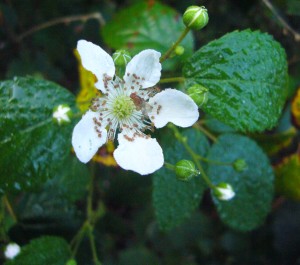
Perhaps a good sign that the worst of winter is over is our blackberries blossoming. These are cane blackberries rather than trailing dew berries. Photo by Green Deane
This year it will be done. This year I will find places in Tallahassee to hold foraging classes. I will also find a good location from Panama City to Pensacola to hold foraging classes. Please send me you location suggestions. Pensacola is 450 miles away. My scheme is to travel to west Florida on a Friday and hold a class there Saturday. Then Saturday afternoon go east to Tallahassee and have a class there on Sunday. Then return to central Florida. I am also investigating scheduling far longer road trips into far flung places (looking at a travel trailer or RV…)
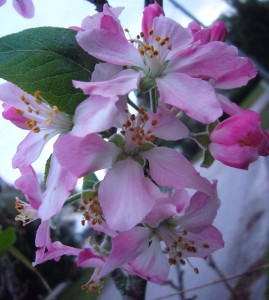
Also blossoming are apples, a relative of the blackberry. These are Apple Anna blossoms, one of the few apple trees to fruit in warm Florida. Photo by Green Deane
Good foraging education locations have drinking water, parking and bathrooms. The mind cannot perceive what the bladder cannot endure. It’s a foraging class not a camp out. While there are exceptions, state parks and the like are not good places to hold classes. They are often nearly mono-culture and have only native plants. Some of the better locations are old city parks and the like. They have lakes or ponds, lawns or fields, trees and often trails. They also usually have many of the weeds people see in their yards and neighborhoods whereas state parks often do not. Questions? Email me.

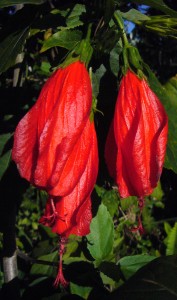
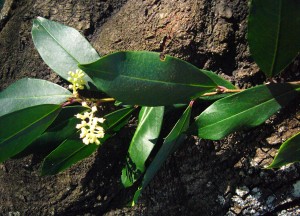
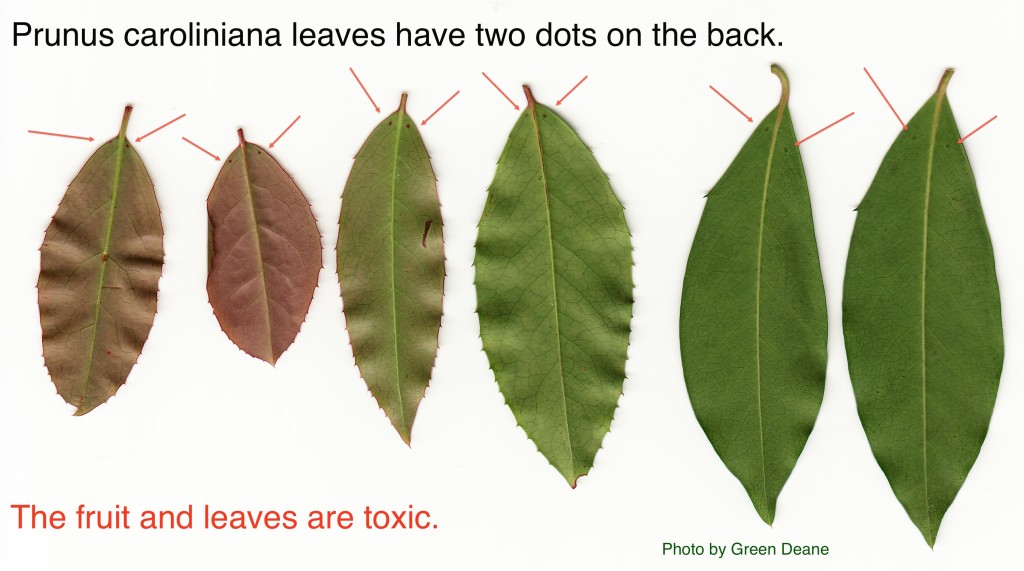
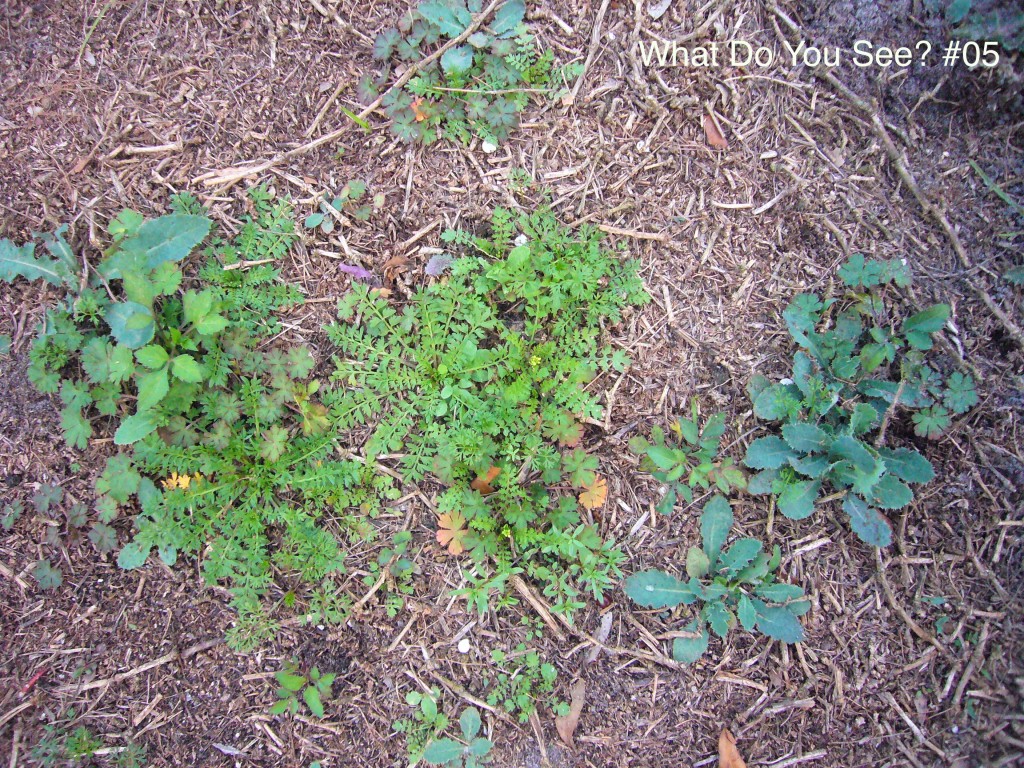
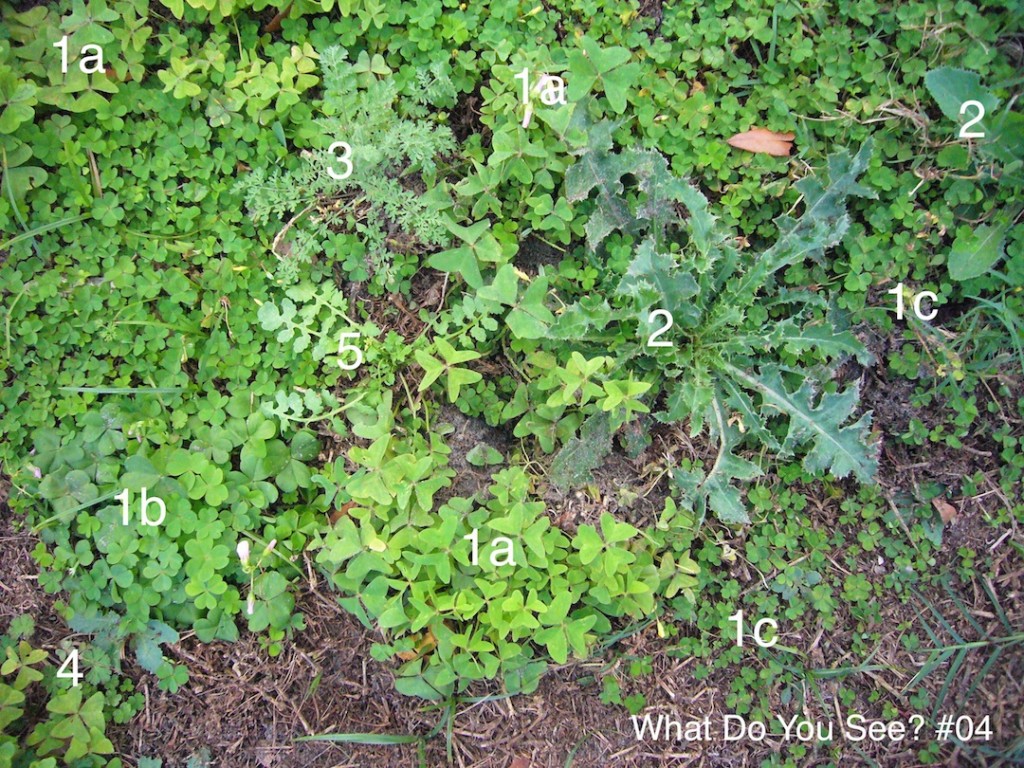
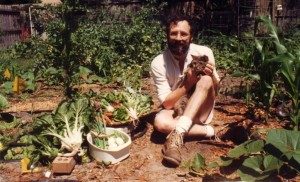

Maybe the plants are different in Florida, but the swinecress that I’m familiar with is Coronopus squamatus, an introduced weed.
Also, I couldn’t find any plant with the genus name “Senico” – did you perhaps mean “Senecio”? Around here, the most commonly found Senecios are S. aureus (golden ragwort) and S. pauperculus (balsam ragwort), but there are a few clumps of locally growing butterweeds. Though the leaves strongly resemble mustards, I generally wait for the flower, because aster family leaves are just NASTY to the taste!
Thanks…. I didn’t notice the spelling. I can misspell in two languages… as for the swinecress…. there are several different species of it.
LOL Misspelling in TWO languages, AND a botanist as well? Is there no end to your talent?
Sure wish we had someone like you here in Illinois. One of our most notable local plant experts has moved on “to greener pastures”, he said — how much greener could Illinois in spring be? Well, given the snow this morning (about 3″ and still coming down), right after two days in the upper 50s, in a few weeks, it’ll be pretty green!
Thanks for keeping us awake and aware. 😉
Deane, I’m sure by now that you know many of us consider you one of our Florida treasures. I’m utterly delighted that you’ll be migrating up to the Panhandle. I’ve only been able to share time with you at the Herb conference due to distance issues. I live in Franklin county. If you have any questions about my area just let me know. As always, I thoroughly enjoyed your edible walk this past weekend. Thanks for sharing your knowledge.
Thank you, that was kind of you to say.
Hi Green. Wow, 14 years living near you, and they did not know who you were…..Amazing. Neighbors don’t meet and talk any longer, well, like they did when I was a kid in the early 70’s. I guess the way some of them are, perhaps that’s a good thing. I wonder what the cops had to say when they arrived?
I have watched a lot of your youtube videos, and I think you look like a college professor, not a shady character at all. Interesting observation, I think you sound a lot like Bill Murry when you speak. Anyone ever tell you that before? And I would be saying that as a compliment. You should attempt to do a Bill Murry impression some time, either on your videos, or during a class. I could only see it if it was on a video however.
If you ever remember some of my recent posts, I’m the guy who is interested in permaculture and wild edibles. I am just about ready to build my garden, and have many wild edible seed to include with my non GMO heirloom veggy seed. And I’m interested in meeting people in my area who are into the same things. I’m in Danville Va, and my email is b_k_j_24541@yahoo.com, if anyone is interested in contacting me. I’d love to share information with others with the same interests. The closest I have found around my area is one person into eating a raw veggy diet…well, that’s close, but don’t find any who are interested in wild edibles. Perhaps some of your readers are in or near my area.
Take care, love the news letters.
There is a drop down menu under “foraging” on my home page. You will see “foraging instructors” there click on it. That will take you to a list of foraging instructors near you. Write to them to fine any local people with the same interest.
Tapping, tapping, and tapping…How generous is Mother Nature. I’ll start tapping this Eattheweeds issue which sweetens our tongues with maple syrup. The Sugar maple – Acer saccharum – has a high concentration of natural sugar to make maple syrup. Sugar is produced in the leaves of the tree during photosynthesis. It is transported into the wood and stored during winter, mostly in the form of carbohydrates and then converted into sucrose and dissolved into the sap. It is noteworthy that in the year 2006 the USA has exported 35633MT of maple products to 48 countries valued at US$118743 millions . Major importing middle east countries are United Arab Emirates and Saudi Arabia. Thank God in my country Sudan cane sugar – from Saccharum officinarum – is considered an important cash crop – “ Kinana Sugar Company – Sudan “ – is one famous project. Let us tap another important type of sugar – Gum arabic – also known as Acacia gum ; it is tapped either from Senegalia tree ( Acacia Senegal ) or Vachellia tree ( Acacia seyal ). Gum Arabic is historically the source of both arabinose and ribose sugars. Sudan is the largest producer of gum Arabic. Gum tapped from Acacia Senegal is known as “ gum heshab “ whereas that tapped from Acacia seyal is called “ talha gum “; the former is of higher grade though both are top ranked worldwide. According to my school geography lessons we can tap rubber latex ( isoprene ) from Hevea brasiliensis . How kind is Mother Nature :Oh my sons just tap and my blessings shall flow ;but do me no harm. Thank you Sir for the sweet Eattheweeds.
Strange that you were harrassed – at the expense of the taxpayers – for taking photos of plants along the street in full public view, but no one seems concerned about the photographs of our homes and grounds not in public view – from the air and space – and shared with anyone with access to the Internet.
It’s OK for corporations, obviously, to photograph every vantage point of every home along every street in America, allowing anyone to ‘case the neighborhood’ remotely via the Internet, but you cannot stroll the street in peace indulging in your right to be in public minding your own business, and to make photographs – a question which was settled legally, as you know, long ago.
Why don’t the police simply inform the public that you have a right to be there? No, don’t answer that question… I’ve been having a pleasant day! Thank you for exercising your basic rights, thus aiding their preservation for us all.